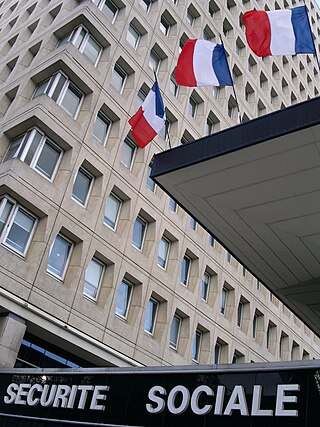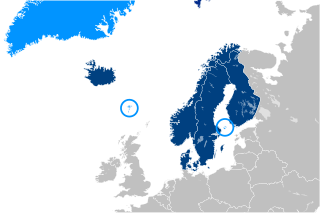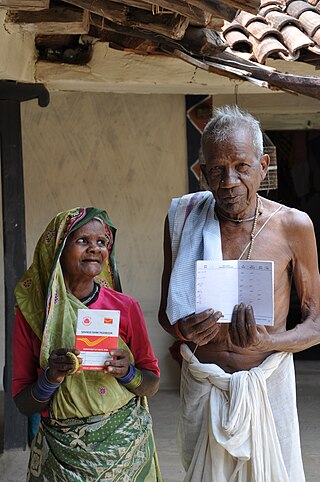
Welfare, or commonly social welfare, is a type of government support intended to ensure that members of a society can meet basic human needs such as food and shelter. Social security may either be synonymous with welfare, or refer specifically to social insurance programs which provide support only to those who have previously contributed, as opposed to social assistance programs which provide support on the basis of need alone. The International Labour Organization defines social security as covering support for those in old age, support for the maintenance of children, medical treatment, parental and sick leave, unemployment and disability benefits, and support for sufferers of occupational injury.
Unemployment benefits, also called unemployment insurance, unemployment payment, unemployment compensation, or simply unemployment, are payments made by authorized bodies to unemployed people. In the United States, benefits are funded by a compulsory governmental insurance system, not taxes on individual citizens. Depending on the jurisdiction and the status of the person, those sums may be small, covering only basic needs, or may compensate the lost time proportionally to the previous earned salary.
Guaranteed minimum income (GMI), also called minimum income, is a social-welfare system that guarantees all citizens or families an income sufficient to live on, provided that certain eligibility conditions are met, typically: citizenship and that the person in question does not already receive a minimum level of income to live on.
A disability pension is a form of pension given to those people who are permanently or temporarily unable to work due to a disability.
Social welfare, assistance for the ill or otherwise disabled and the old, has long been provided in Japan by both the government and private companies. Beginning in the 1920s, the Japanese government enacted a series of welfare programs, based mainly on European models, to provide medical care and financial support. During the post-war period, a comprehensive system of social security was gradually established.
Social security, in Australia, refers to a system of social welfare payments provided by Australian Government to eligible Australian citizens, permanent residents, and limited international visitors. These payments are almost always administered by Centrelink, a program of Services Australia. In Australia, most payments are means tested.

The Italian welfare state is based partly upon the corporatist-conservative model and partly upon the universal welfare model.

Social security is divided by the French government into five branches: illness; old age/retirement; family; work accident; and occupational disease. From an institutional point of view, French social security is made up of diverse organismes. The system is divided into three main Regimes: the General Regime, the Farm Regime, and the Self-employed Regime. In addition there are numerous special regimes dating from prior to the creation of the state system in the mid-to-late 1940s.
Welfare in France includes all systems whose purpose is to protect people against the financial consequences of social risks.

Social security or welfare in Finland is very comprehensive compared to what almost all other countries provide. In the late 1980s, Finland had one of the world's most advanced welfare systems, which guaranteed decent living conditions to all Finns. Created almost entirely during the first three decades after World War II, the social security system was an outgrowth of the traditional Nordic belief that the state is not inherently hostile to the well-being of its citizens and can intervene benevolently on their behalf. According to some social historians, the basis of this belief was a relatively benign history that had allowed the gradual emergence of a free and independent peasantry in the Nordic countries and had curtailed the dominance of the nobility and the subsequent formation of a powerful right wing. Finland's history was harsher than the histories of the other Nordic countries but didn't prevent the country from following their path of social development.

The National Pension Service of Korea is a public pension fund in South Korea. It is the third largest in the world with over $800 billion in assets, and is the largest investor in South Korea.
A social pension is a stream of payments from state to an individual that starts when someone retires and continues in payment until death. It is a part of a pension system of most developed countries, specifically the so-called zero or first pillar of the pension system, which is a part of state social security system. The social pension is different from other types of pension since its eligibility criteria do not require former contributions of an individual, but citizenship or residency and age or other criteria set by government.

The National Social Assistance Programme (NSAP) is a Centrally Sponsored Scheme of the Government of India that provides financial assistance to the elderly, widows and persons with disabilities in the form of social pensions. The NSAP scheme only includes Below Poverty Line individuals as beneficiaries.

Poverty in South Korea has been in drastic decline since the mid-20th century, particularly the absolute poverty rate. Relative poverty was also in decline until the late 1990s, rose in the aftermath of the Asian Financial Crisis, and has been in decline since the 2010s. While only about 2% of South Koreans are affected by absolute poverty today, about 14-15% of these 2% are elderly and are affected by relative poverty. Elderly relative poverty has been in consistent decline since 2011, according to the OECD.
The Swiss pension system rests on three pillars:
- the state-run pension scheme for the aged, orphans, and surviving spouses ;
- the pension funds run by investment foundations, which are tied to employers ;
- voluntary, private investments.
Luxembourg has an extensive welfare system. It comprises a social security, health, and pension funds. The labour market is highly regulated, and Luxembourg is a corporatist welfare state. Enrollment is mandatory in one of the welfare schemes for any employed person. Luxembourg's social security system is the Centre Commun de la Securite Sociale (CCSS). Both employees and employers make contributions to the fund at a rate of 25% of total salary, which cannot eclipse more than five times the minimum wage. Social spending accounts for 21.8% of GDP.
Welfare in Peru began on a base of democratic views. Its political system is a multi-party system that includes having a President and Prime Minister. The economy of Peru has expanded substantially throughout the years making it one of the fastest growing economies. As described by Gøsta Esping-Andersen, in his book The Three Worlds of Welfare Capitalism, the Peruvian welfare system would most commonly fit in with the liberal model, since Peru mostly attempts to emancipate the less fortunate from poverty, through means of state-cultivated programs. In accordance, the welfare system has shown great expansion, with the focus primarily on education, healthcare, and the creation of a social safety net.
Cyprus is a high income country with a well established and extensive welfare system. The Social Insurance Scheme ensures access to healthcare, income support, and pensions, with mandatory contributions for all employees and employers. Income support is means tested on the basis of total family income and assets, which often places the burden of care on the family unit before the state provides assistance. There is also an obligation to seek work. The pension system is fairly comprehensive, yet may still leave some in the private sector unsupported.
South Korea introduced its Basic Old-Age Pension in 2008 as part of its pension system. According to the Ministry of Health, Welfare and Family Affairs, the Basic Old-Age Pension is "designed to enhance welfare of the elderly by providing a monthly pension payment to the elderly in need." The pension was intended to benefit workers contributing to the National Pension Scheme.








